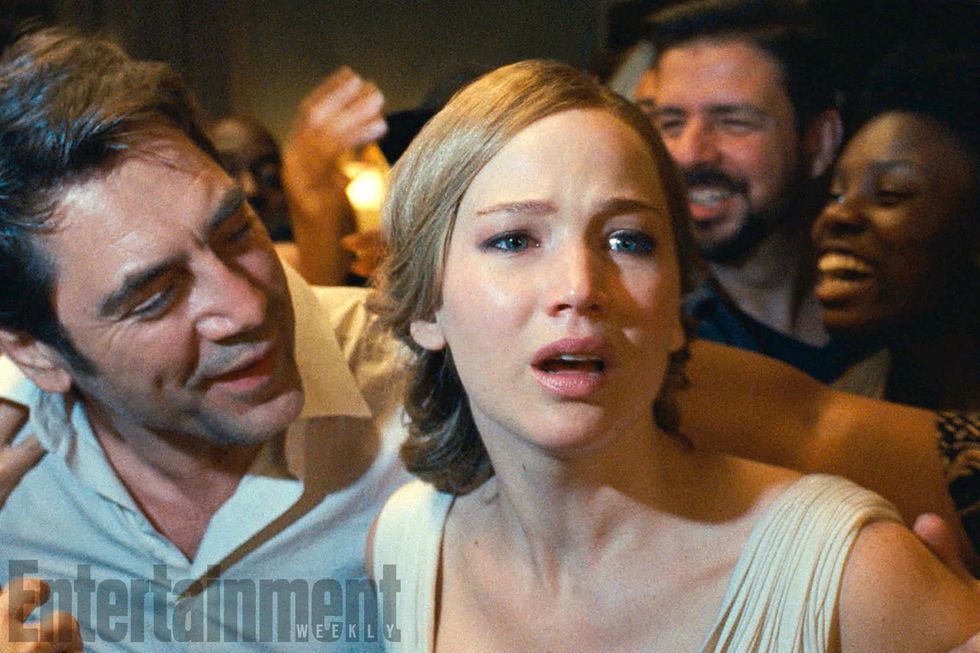Darren Aronofsky’s mother is an allegory about God and Mother Earth. Javier Bardem is supposed to be God and Jennifer Lawrence is supposed to be Mother Nature. I had mixed feelings about this film. I thought the first three-quarters of the film lagged, but then got a little more entertaining towards the end. The couple played by Michelle Pfeiffer and Ed Harris were representative of Adam and Eve. Their two sons played by Brian and Domhnall Gleeson were symbolic of Cain and Abel. When Ed Harris gave his will to Brian Gleeson, Domhnall Gleeson’s character kills his brother. I felt like the murder of the brother was forced. The baby Jennifer Lawrence and Javier Bardem have in the third act is supposed to represent Jesus. When fans of Javier Bardem’s poetry come to party at the house, the baby crowd-surfs with them, and then they drop and kill the baby. After the death of the baby, the people eat the baby like the “body of Christ.” My jaw dropped when the baby was killed in a good way. That scene almost gave me nightmares. At the same time, however, I did not buy them eating the body of the baby that quickly after the death. Seriously, the visitors eat the body of the baby a couple of seconds after he dies. Undoubtedly, the visitors and fans of Javier Badem’s poetry admire Javier Bardem’s character more than Jennifer Lawrence’s. This reflects how several people in society give more credit to God than Mother Nature. This is true. As much as I admired this point of the allegory, but I felt like the characters were one-dimensional symbolic caricatures. That being said, I think Mother would have worked better as a short film containing only the third act of the narrative.
As stated previously, I did not find Javier Bardem and Jennifer Lawrence’s symbolic characters believable, particularly Javier Bardem’s. I thought Bardem was cartoonish, especially when he held the crystal which was Mother Nature’s heart. Truthfully, I found Jennifer Lawrence’s character more believable than Javier Bardem’s. I felt bad for her because Javier Bardem was dismissive of her, and the house visitors had no respect for her. Nevertheless, Jennifer Lawrence’s submissiveness is part of what irritates me about this film. Jennifer Lawrence said in an interview that she views Mother as a feminist film. I can understand why she thinks that because the audiences are meant to feel sorry for Mother Nature. Personally, I thought it was misogynistic. Regardless of whether or not you feel sorry for Lawrence’s character, I thought it was misogynistic how she let Javier Bardem take her heart out of her body at the end of the film. It’s one thing for an oppressed female character to evoke sympathy in audiences, but a woman defending and asserting herself is a completely different story.
This brings me to the house in the film. Christy Lemire in What The Flick’s review called the house a character. It the setting of the film as well as a character and a symbol for the Garden of Eden and the Earth in general. In the film, the house has a beating heart that Jennifer Lawrence’s character constantly checks on. Oddly, this made me think of that Cat in the Hat movie in 2003 when Alec Badlwin’s character yells “THE HOUSE WAS ALIVE.”
Darren Aronofsky is known for his surreal symbolism, particularly in Black Swan. The characters in Black Swan, however, had depth. They weren’t just symbols. Black Swan was aware of it’s metaphors, but it was not attached to them in the way that Mother is. Mother, on the other hand, is so aware of its metaphors that it is almost like Darren Aronofsky wrote and directed the film just to have audiences put allegorical puzzle pieces together.
Darren Aronofsky is not the only filmmaker accused of using symbolism and surrealism reflecting the dark side of humanity. In fact, Lars von Trier and David Lynch are known for this quality as well. However, Lars von Trier and David Lynch’s characters are much more deep and complex. If you want to watch a legitimately provocative allegory with truly complex characters, then watch Lars von Trier’s Melancholia. Melancholia is not for everyone, but it is a beautiful allegory of depression that does not focus solely on the end of the world. A major plot element in Melancholia is the story is the relationship between the two sisters played by Kirsten Dunst and Charlotte Gainsbourg. Lars von Trier does not attach the narrative to the symbols in the way that Darren Aronofsky does with Mother.
Another narrative technique Darren Aronofsky used in Mother was not giving the characters names. Jennifer Lawrence's character is referred to as "mother," and Javier Bardem's character is referred to as "Him." Lars von Trier used this technique in Antichrist. Willem Dafoe's character is called "He" while Charlotte Gainsbourg's character is called "She." Yorgos Lanthimos also uses this narrative style in The Lobster and Dogtooth. The Lobster has metaphors as well, but it does not rely on it's metaphors to tell the story.
My overall rating for Mother is a 5/10. It is worth seeing to get a taste of, and I do like the point it makes about God being praised more than Mother Nature. Nonetheless, the obvious symbolism, at least for me, was directorial self-indulgence.















